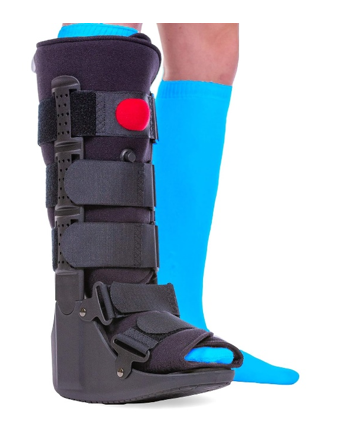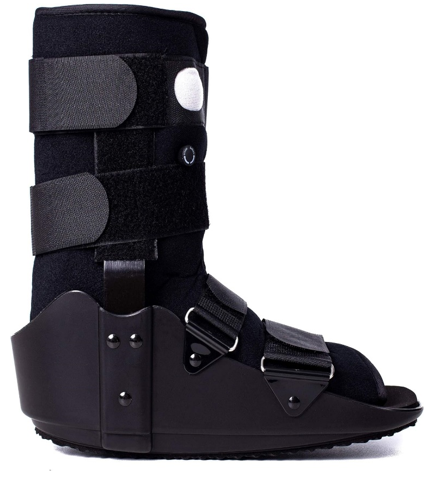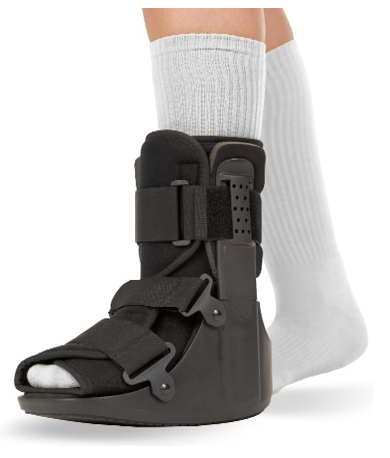Best pneumatic walking boots represent a remarkable advancement in orthopedic technology designed to enhance the rehabilitation experience for individuals recovering from lower limb injuries or surgeries.
These innovative devices integrate pneumatic chambers that can be inflated or deflated to provide customized support and compression, effectively reducing pain, promoting healing, and restoring mobility.
Their ergonomic design and adaptable nature have become indispensable tools for patients and healthcare professionals alike, ensuring a smoother and more comfortable path towards recovery and improved quality of life.
What Is A Pneumatic Boot?
A pneumatic boot, also known as an air cast boot or walking brace, is a medical device used to support and immobilize the lower leg and foot during the healing process of injuries or surgeries.
It consists of a rigid shell that surrounds the leg and foot, which is typically made of plastic, and inflatable air chambers or bladders integrated into the design.
These air chambers can be inflated or deflated using a pump, allowing for adjustable compression and support.
The primary purpose of a pneumatic boot is to provide stability and protection to the injured area while allowing for some degree of mobility.
Buying Guide: What To Consider When Buying Best Pneumatic Walking Boots
Here are some key considerations:
1.Prescription and Consultation
These boots are typically prescribed by a healthcare professional. Ensure that you have a proper diagnosis and prescription before buying one. Consult with your doctor or orthopedic specialist to determine the most suitable type and size for your condition.
2.Size and Fit
The correct size and fit are crucial for comfort and effectiveness. Ensure to follow the manufacturer’s sizing chart or guidance provided by your healthcare provider. A properly fitted boot should immobilize your injured limb while still allowing some mobility.
3.Type of Injury or Condition
Different injuries or conditions may require specific types of pneumatic boots. Some are designed for ankle injuries, while others provide support for the entire lower leg. Ensure that the boot you choose is appropriate for your particular injury or surgery.
4.Adjustability
Look for a boot with adjustable features, such as inflatable air chambers. This allows you to customize the level of compression and support based on your comfort and the progress of your recovery.
5.Ease of Use
Consider how easy it is to put on and take off the boot, especially if you will be wearing it for an extended period. Features like quick-release buckles or straps can make the process more manageable.
6.Comfort
Comfort is essential during the healing process. Look for boots with cushioning or padding in the areas that are exposed to your skin. Some boots also have breathable materials to reduce sweating and discomfort.
7.Durability and Quality
Quality matters when it comes to medical devices. Choose a reputable brand and ensure that the boot is made from durable materials to withstand regular use.
8.Weight and Mobility
Consider your ability to move around while wearing the boot. Some models are lighter and more conducive to walking, while others are bulkier and may limit mobility.
9.Cost and Insurance Coverage
Pneumatic walking boots can vary in price. Check with your insurance provider to see if they cover the cost of the boot. If not, discuss pricing and payment options with your healthcare provider.
10.Maintenance
Inquire about cleaning and maintenance requirements. Some boots may have removable liners that are machine washable, making them easier to keep clean.
11.Follow-Up Care
Ensure that you understand the recommended duration of use and any follow-up appointments with your healthcare provider. They can assess your progress and determine when it is safe to discontinue using the boot.
Remember that the choice of a pneumatic walking boot should be made in consultation with your healthcare provider to ensure it meets your specific medical needs and promotes a successful recovery.
It is our hope the following list will guide you on choosing the best pneumatic walking boots to fit your needs
Best Pneumatic Walking Boots
-
Brace Direct Medical Full Shell Walking Boot with Air Pump

Brace Direct Walking Boot provides increased immobilization while offering the protection of a full shell-walking boot. It is ideal for soft tissue injuries, grade 2 and 3 sprains, stable fractures, Achilles tendon rupture and post-operative stabilization and helps to reduce pain, swelling and edema of foot and ankle.
Feature
- Inflatable air bladder
- Toe guard
- Ventilated outer shell
- Cushioned sole
- Rocker bottom sole
Pros
- Provides pneumatic compression
- Durable outer shell
- Can be adjusted
- Comes in multiple sizes
- Lightweight
- Promotes a more natural walking gait
Cons
- One size doesn’t fit all
-
Aircast Extra Pneumatic Walker Brace/Walking Boot

It is specifically designed to provide protection and pneumatic support for stable fractures of the foot and ankle, severe ankle sprains, soft tissue injuries, chronic conditions including plantar fasciitis, metatarsal fractures, forefoot and midfoot injuries, bunionectomies and post-operative use.
Features
- Measures 21.3 x 11.4 x 4.9 inches
- Low rocker sole
- Two adjustable Duplex air cells
- Weighs 2.4 Pounds
- Semi rigid shell
- Brace lock system
- Pre inflated anterior air cell
- Includes two sock liners
- Has a hand bulb air pump
Pros
- Has a removable cast
- Lightweight
- It is two in one (cast and a boot)
- Promotes a natural ambulation
- Customizable
- Comes in multiple sizes
- Universal fit
Cons
- Requires inflation from a bulb you have to carry around
-
ZOYER Recovery+ 17″ Pro Walker Boot with Dual Pumps

It is built as an ideal recovery support for a wide range of foot sprains and injuries including Grade II/III ankle sprains, Stable fracture of the fibula, talus, calcaneus and medial malleolus, Post ligament, soft tissue, or tendon surgery, Forefoot or midfoot injury.
Features
- Dual air cells
- Double pumps
- Athletic outsole
- Front panel shell
- Anti-slip technology
Pros
- Superior comfort and support
- Adjustable inflation
- Universal fit
- Quick and effortless inflation.
- Multiple sizes
Cons
- Small sized calf area.
-
BraceAbility Tall Pneumatic Walking

BraceAbility Tall Pneumatic Walking Boot is clinically proven to offer mobility, protection, and support for calf tear, ankle sprains, stress fractures, postoperative use, foot fracture relief, metatarsal breaks, broken foot recovery and Achilles tendonitis.
Features
- Deluxe foam liner
- Air cell technology
- Wide toe bed
- Open toe design
- Low profile rocker bottom
- Medical grade fastener straps
- Rigid polymer plastic reinforced shell
Pros
- Comfortable
- Adjustable air cell
- Personalized compression
- Enhanced stability
- Easily adjustable fastener straps
- Multiple sizes
- Universal fit
Cons
- Not ideal for large calves
-
Ovation Medical Gen 2 Short Pneumatic Walking Boot

If you are looking for the lightest, most advanced walker on the market then Ovation Medical Gen 2 Short Pneumatic Walking Boot is a great choice for you.
Features
- Built in Shock Pod
- Single push button release system
- Impact resistant resting surface
- Contoured front to back and side to side
- Low Profile CAM Walker Boot
Pros
- Lightweight
- Easy to use
- Sleek design
- Promotes a natural gait
- No shoe levelers needed
- Dependable inflation
- accommodate all calf circumferences
-
Kefit Walking Boot

This Amazon’s choice walking boot is ideal for stress fractures of the foot and ankle, sprained ankle, broken foot, soft tissue injuries, Achilles tendon rupture and postoperative rehabilitation.
Features
- Measures 13.4 x 11.5 x 4.6 inches
- Built in inflatable bag
- Weighs 1.9 Pounds
- Built in inflatable compression
- Aluminum brackets on both sides
- Rocker bottom design
- Medium size
Pros
- Provide excellent protection.
- Improve normal walk
- Available in multiple sizes
- Comfortable
- Affordable
- Lightweight
- Sturdy
- Easy to use
- Easily washable
- Multiple sizes available
- Promotes natural gait during rehabilitation
Cons
- Needs a little more cushion on heel of foot
-
ManaMed ManaEZ Air Boot Tall CAM Boot

The ManaEZ air cast offers protection, mobility and support when doing daily activities while recovering from a variety of ankle and foot injuries, including sprain, broken foot, and stable fractures of the foot, ankle, and lower leg.
Features
- Measures 17.92 x 12.99 x 6.42 inches
- Rocker foot bottom
- Weighs 2.1 Pounds
- Cushioned insole
- Cast padding
- Air bladder
- Professional grade Velcro
- Tall reinforced plastic shell
Pros
- Can be worn on both the left and right foot.
- Stimulates natural gait
- Lightweight
- Easy to use
- Comes in multiple sizes
- air bladder embedded in the boot liner
-
Ossur Rebound Air Walker Boot with Compression

Ossur rebound air walker boot with compression is ideal for foot and ankle conditions that require motion restriction such as, grade two and three ankle sprains, stable foot fractures, tendon or ligamentous sprain. If used with the Achilles wedge kit, Achilles ruptures can be treated as well
Features
- Measures 12.2 x 11.42 x 5.31 inches
- Ventilated panels
- Semi soft toe bumper
- Weighs 2 Pounds
- Air pump rocker bottom
- Linked medial and lateral air bladders
Pros
- Adjustable straps
- Comfortable liner
- Conforms to each patient’s unique anatomy
- Promotes a natural stable gait
- Provides uniform compression
- Lightweight
Cons
- Covers the toes
-
Aircast SP (Short Pneumatic) Walker Brace/Walking Boot

Aircast SP is specifically designed for foot and ankle injuries and its shorter height makes it ideal for individuals whose limb length or calf circumference prohibits them from using a standard height-walking boot.
Features
- Two distal air cells
- Pulsating graduated compression
- Hand Bulb for inflation
- Semi rigid shell
- Rocker sole
Pros
- Easy to clean
- Provide protection similar to a cast
- Helps reduce edema
- Lightweight
- Ideal for post-op patients
Cons
- No return policy
-
BraceAbility Short Walking Boot

BraceAbility Short Walking Boot is ideal for sprain, swelling, bunion and fracture of the foot. It provides supportive protection for both men and women. It is suitable for post-operative care or injury recovery
Features
- Measures 11 x 10.8 x 5.1 inches
- Low profile rocker bottom
- Weighs 2 Pounds
- Sturdy sole
- Medical grade straps
- Deluxe foam liner
- Open toe design
- Made from rigid polymer plastic
Pros
- Available in various sizes
- Provides a natural step
- Comfortable
- Lightweight
- Adjustable straps
- Comes in multiple sizes
- Left and right foot options available
Cons
- Makes sound on walking
You may also like
6 best portable oral irrigators
7 best ear syringing equipment
5 best standing aids for elderly people
When To Use Pneumatic Boots
They are typically used in a variety of medical situations where support, immobilization, and controlled compression of the lower leg, ankle, or foot are necessary.
Here are some common scenarios and conditions when pneumatic boots may be used:
Fractures: they are often prescribed for individuals with fractures of the foot, ankle, or lower leg to provide support, immobilization and promote proper healing.
Sprains and Strains: In cases of severe ankle or foot sprains and strains, a pneumatic boot can help reduce pain and stabilize the injured area during the recovery process.
Post-Operative Recovery: After certain surgeries, such as those involving the ankle or Achilles tendon, pneumatic boots are used to protect the surgical site, minimize swelling, and facilitate healing.
Stress Fractures: For stress fractures in the lower leg or foot, these boots can help distribute weight more evenly and provide support during ambulation.
Tendonitis and Tendon Ruptures: Conditions like tendon ruptures, Achilles tendonitis or posterior tibial tendonitis may require the use of a pneumatic boot to alleviate strain on the affected tendon and promote healing.
Ligament Injuries: For injuries to the ligaments in the ankle or foot, pneumatic boots can offer stability and protect the injured area.
Foot Ulcers: In some cases of foot ulcers, especially in individuals with diabetes, pneumatic boots may be used to offload pressure from the affected area, aiding in wound healing.
Plantar Fasciitis: While not the primary treatment, some individuals with plantar fasciitis may find relief from pain by using a pneumatic boot, which can provide temporary relief from weight bearing.
It is important to note that the use of pneumatic boots should always be prescribed by a healthcare professional, such as an orthopedic specialist or physician, based on a thorough evaluation of your specific injury or condition.
Advantages Of Pneumatic Boots
Here are some of the key advantages:
- Provides customized compression and support
- Pneumatic boots helps reduce swelling (edema) around the injured region.
- They help to immobilize the injured limb, providing stability and preventing further injury.
- They enable controlled and safe mobility, prevent muscle atrophy and maintain joint mobility.
- By providing support and reducing pressure on the injured area, pneumatic boots can alleviate pain and discomfort.
- Their ease of use can make the rehabilitation process more manageable.
- These boots protect the injured limb from external factors, such as accidental bumps or impacts.
- The boots can help prevent complications associated with immobilization, such as deep vein thrombosis (DVT) or pressure sores.
- Pneumatic boots often allow for earlier weight bearing compared to traditional casts, which can lead to a faster recovery.
- Patients tend to find pneumatic boots more comfortable and tolerable than traditional casts, which may lead to better compliance with treatment plans.
- The boots are versatile and can be used for a wide range of lower limb injuries and conditions, making them a valuable tool in orthopedic rehabilitation.
FAQs For Best Pneumatic Walking Boots
Are pneumatic boots covered by insurance?
Insurance coverage varies so check with your insurance provider to see if pneumatic boots are included in your policy. Your healthcare provider can also assist with obtaining any necessary documentation for coverage.
How do I adjust the compression in a pneumatic boot?
Pneumatic boots have inflatable air chambers that can be adjusted using a pump or a provided bulb. Follow your healthcare provider’s instructions to achieve the appropriate level of compression.
Can I walk with a pneumatic boot?
Yes, pneumatic boots are designed to allow controlled walking while providing stability and support. Patients typically use crutches or a walker during the initial stages of recovery.
How do I choose the right size?
To choose the correct size, consult with your healthcare provider and follow the manufacturer’s sizing guidelines. A proper fit is crucial for comfort and effectiveness during your recovery.
Conclusion
In conclusion, the utilization of the best pneumatic walking boots plays a pivotal role in the realm of orthopedic rehabilitation. Their versatility, ease of use, and adaptability to changing recovery needs make them a preferred choice for both patients and healthcare professionals.
In this article, we have provided you with a buying guide and a number of variable options to choose from them.
It is good to note that when prescribed and used correctly, they contribute significantly to the comfort, convenience, and successful recovery of individuals, facilitating their journey toward regaining mobility and a higher quality of life.

